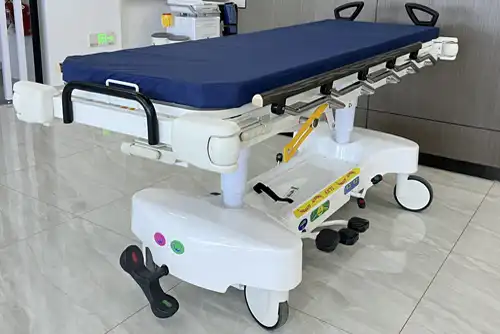How to Repair a Medical Transfer Bed?
2024-03-22 17:17:23
Introduction: Understanding the Importance of a Functional Medical Transfer Bed
In the realm of healthcare, particularly within small-scale laboratory settings, the functionality of medical transfer beds holds paramount importance. These specialized beds facilitate the safe and efficient transfer of patients between different areas within a medical facility. Whether it's moving a patient from a stretcher to an examination table or transferring them for diagnostic procedures, a well-maintained transfer bed is essential for ensuring both patient comfort and caregiver safety.
Assessing Common Issues with Medical Transfer Beds
Before delving into repair techniques, it's crucial to identify common issues that may arise with medical transfer beds. These issues often include malfunctioning hydraulic systems, damaged siderails, worn-out wheels, or electrical problems with integrated features such as height adjustment or Trendelenburg positioning. Each of these issues requires a targeted approach to restore the functionality of the transfer bed effectively.
Troubleshooting Hydraulic System Malfunctions
One of the most prevalent issues encountered with medical transfer beds involves malfunctioning hydraulic systems. These systems are responsible for enabling smooth height adjustments, crucial for accommodating different medical procedures and patient needs. When faced with hydraulic system malfunctions, the following steps can aid in troubleshooting and repair:
Inspecting Hydraulic Lines: Begin by visually inspecting the hydraulic lines for any signs of leaks or damage. Even minor leaks can significantly impact the bed's functionality and must be addressed promptly.
Fluid Level Check: Verify the hydraulic fluid levels according to the manufacturer's specifications. Low fluid levels can lead to inadequate pressure, resulting in erratic bed movements or failure to adjust height properly.
Seal and O-Ring Examination: Check the seals and O-rings within the hydraulic system for signs of wear or deterioration. Damaged seals must be replaced to prevent fluid leakage and ensure optimal performance.
Hydraulic Pump Evaluation: Assess the hydraulic pump for any signs of mechanical issues such as worn-out components or motor failure. In some cases, professional servicing or replacement of the pump may be necessary to resolve the issue comprehensively.
Addressing Siderail and Wheel Damage
Siderails and wheels are integral components of a medical transfer bed, contributing to both patient safety and maneuverability. Damage to these parts can impede the smooth operation of the bed and pose potential risks to patients and caregivers. Here's how to address common issues related to siderails and wheels:
Siderail Inspection: Regularly inspect the siderails for any signs of damage, such as cracks, bends, or loose fasteners. Ensure that siderails are securely attached to the bed frame to prevent accidents during patient transfers.
Wheel Alignment and Lubrication: Check the alignment of the bed wheels and ensure that they rotate freely without any obstructions. Lubricate wheel bearings as per the manufacturer's recommendations to maintain smooth movement, especially when navigating tight spaces within the laboratory.
Wheel Replacement: If wheels show signs of significant wear or damage, consider replacing them with compatible replacements sourced from reputable suppliers. Opt for medical-grade wheels designed to withstand frequent use and provide enhanced stability during patient transfers.
Resolving Electrical System Issues
Many modern medical transfer beds feature integrated electrical systems responsible for powering various functionalities such as height adjustment, Trendelenburg positioning, and patient monitoring capabilities. When confronted with electrical system issues, meticulous troubleshooting is essential to identify and resolve the underlying problems:
Power Supply Check: Begin by verifying the power supply to the transfer bed and ensure that electrical connections are secure. Use a multimeter to assess voltage levels and identify any irregularities that may indicate wiring faults or power surges.
Control Panel Examination: Inspect the bed's control panel for any malfunctioning buttons, switches, or display indicators. Clean the control panel interface to remove any debris or residue that could interfere with proper functionality.
Component Testing: Test individual electrical components such as motors, actuators, and sensors to pinpoint the source of the issue. Replace faulty components with genuine replacements to restore the bed's full functionality and ensure compliance with safety standards.

Conclusion: Prioritizing Maintenance and Repair for Optimal Patient Care
In conclusion, the effective repair of medical transfer beds is essential for maintaining the seamless operation of healthcare facilities, particularly within small-scale laboratory settings. By promptly addressing common issues such as hydraulic system malfunctions, siderail and wheel damage, and electrical system issues, caregivers can ensure the safety and comfort of patients undergoing medical procedures. Regular maintenance and adherence to manufacturer guidelines are critical aspects of preserving the longevity and reliability of medical transfer beds, ultimately contributing to enhanced patient care outcomes.
References:
Troubleshooting Hydraulic Systems - Machinery Lubrication
Maintenance Tips for Medical Equipment - Meditek
Electrical Safety in the Laboratory - OSHA

